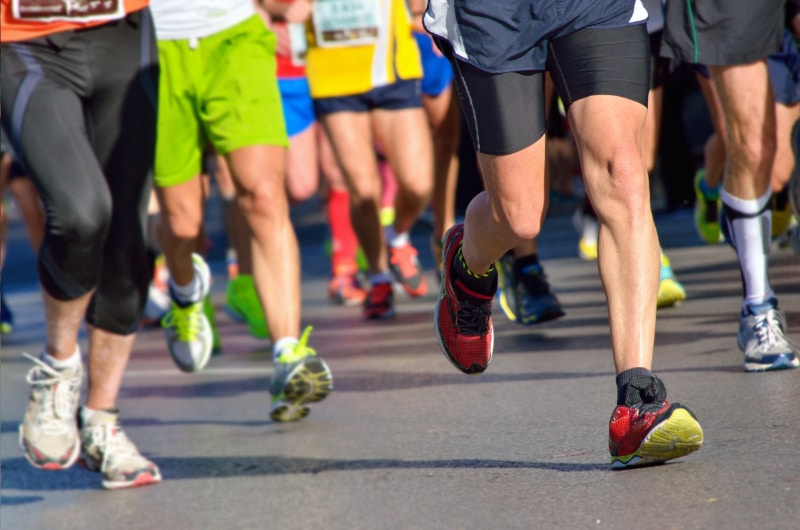Foot Strike Patterns: Heel, Midfoot, or Forefoot?
When we think about running, most focus on broad strokes such as pace, distance, and form. Yet, when delving deeper into our stride mechanics, we often overlook an interesting detail called Foot Strike Patterns, which affect not only how our feet meet the ground but also our running efficiency, risk of injury, and overall performance.
Understanding Your “Foot Strike Patterns” Understanding your foot strike patterns is like understanding a musical score; whether it’s your first marathon or casual weekend jog, how your foot lands play an essential part in your running journey. Just like the initial brush stroke can set the scene for great works of art, your foot strike sets the tempo for each run.
Before you start scrutinizing your feet mid-run and risk tripping over, let’s take a step back and deconstruct this idea. Within the wide world of running, there are three primary “Foot Strike Patterns,” each having their characteristics and fans. This article aims to shed light on these patterns so you can identify yours and understand their effect on your running journey. So buckle up (or should I say, lac up?) for this foot-focused journey!
The Science Behind Foot Strike Patterns
Diving into “Foot Strike Patterns” goes far beyond simply noting which part of your foot hits first; rather, it involves discovering the complex biomechanics behind each step and understanding its impact on bones, muscles, tendons, and lower extremity tissues in our lower extremities. Just as building foundations ensures stability for its residents, how our foot interacts with the ground creates the basis of running form.
Our feet are marvels of engineering. Their ability to absorb shock, distribute weight evenly, and propel us forward is a result of complex interactions between physics and physiology; “Foot Strike Patterns” play an essential part here – for instance, a heel strike may allow more initial shock absorption by the heel while forefoot strikes see the calf muscles and Achilles tendon absorb more force – this variance in force distribution has the power to impact running efficiency, energy expenditure, and injury susceptibility.
But why does this matter? Think about driving with misaligning wheels, still moving forward but incurring more wear and tear and less efficiency than expected. Recognizing and optimizing Foot Strike Patterns can make running more efficient while decreasing injury risks, making you faster! In subsequent sections, we’ll dive deeper into each pattern, but for now, let’s appreciate its biomechanical marvel!
Heel Strike
Let’s begin our discussion of recreational running “Foot Strike Patterns” with one of the most prevalent: heel strike. As its name implies, this pattern involves making first contact with the ground via your heel — similar to when planes land with only their rear wheels touching down first compared with all four wheels of an aircraft. Before deciding whether this pattern is ‘right or wrong’ for you, let’s dive into its specifics.
Heel striking is distinguished by an extended foot position when making contact with the ground, which often results in what’s referred to as an “overstride.” Due to the biomechanics of heel striking, an unpleasant shock can be sent up the leg from where your heel acts as the primary shock absorber – but don’t despair just yet! Modern running shoes typically provide extra cushioning in their heel area that caters specifically to heel strikers and helps minimize impact forces on impactful landings.
Understanding “Foot Strike Patterns,” especially heel striking, requires an even-handed perspective. While some critics contend that heel striking may increase impact forces leading to injuries, others consider it natural and efficient for many runners. Like all forms of running, individual differences play a pivotal role; understanding one’s body and the mechanics of heel striking is paramount to making informed decisions about form and footwear choices.
Midfoot Strike
Moving further into “Foot Strike Patterns,” we come to the midfoot strike – commonly considered the middle ground in running biomechanics. When employing this pattern, both balls of the foot and a portion of the heel usually land simultaneously, creating an even distribution of impact akin to when gymnasts land squarely after routines; it has similar symmetry and balance when applied by midfoot strikers.
Midfoot strikes can be seen as a hybrid approach that draws elements from both heel and forefoot strikes. Biomechanically speaking, they correspond with a more upright posture and landing closer to their center of gravity. Such landing reduces braking effects seen with pronounced heel strikes for smoother transitions and reduced impact peaks – potentially making for smoother transitions overall and potentially leading to smoother transitions and decreased impact peaks – something many runners find desirable! This might even represent their “Foot Strike Patterns” goldilocks zone for many runners!
However, when exploring the intricacies of “Foot Strike Patterns,” it’s essential to remember that no single foot strike pattern is universally superior. While midfoot striking may provide biomechanical advantages like decreased knee stress, such as Achilles tendon stretching or increased demands on calf muscles – ultimately, what matters is finding what feels most natural, efficient, and injury-free for an individual runner – so taking time to understand their unique stride will lead to running success!
Forefoot Strike
Continued our “Foot Strike Patterns” examination, we now arrive (pun intended) at the forefoot strike pattern. Here, the ball of the foot first makes contact with the ground while its heel often stays above or lightly touches it afterward – like ballet dancers on pointe or sprinters; there’s an inherent springiness and forward propulsion associated with this foot strike pattern.
Historical accounts suggest that before cushioned running shoes were popularized, humans likely ran with either a forefoot or midfoot strike when running without footwear, especially when running barefoot or with minimal footwear. A forefoot strike often involves landing with an extended ankle flexed and knee slightly bent as shock absorbers; this “Foot Strike Pattern” can reduce impact forces on joints while increasing speed and agility while running faster distances.
As with any “Foot Strike Pattern,” the forefoot strike poses unique considerations. While it can increase energy return and speed, it places greater demands on calf muscles and Achilles tendon if not trained correctly – potentially leading to strain or overuse injuries in some instances. Therefore, whether naturally drawn towards it or transitioning, understanding its benefits, challenges, and implications is vitally important to ensure harmonious contact with every ground contact.
Transitioning Between Foot Strike Patterns
Entering the world of “Foot Strike Patterns,” some runners frequently consider altering their natural foot strike for various reasons, whether performance-related, injury prevention-based, or just plain curiosity. Making this transition can be likened to changing serve techniques in tennis or adopting different music-playing styles; both processes offer potential benefits while demanding participants’ dedication, understanding, and patience.
Should I Change My Foot Strike?” is often asked. Unfortunately, the answer to this question can vary; research suggests runners tend to develop the most cost-efficient “Foot Strike Pattern” for their unique biomechanics over time. However, if injury-causing foot strikes persist or there’s room for efficiency enhancement, switching them may be worthwhile; someone prone to shin splints caused by overly heel striking may wish to consider switching up to midfoot or forefoot striking techniques as alternatives.
Transitioning between “Foot Strike Patterns” requires an incremental change, as sudden shifts may introduce stressors or cause injuries. Therefore, it’s crucial to gradually adopt the new foot strike – perhaps using it in short intervals and gradually increasing it as comfort and muscle memory develop. Footwear is also essential – each foot strike pattern has an ideal shoe type that offers support and cushioning as needed.
Foot Strike Patterns provide a vast array of choices for runners. Each runner’s stride should be treated as an individual, and transitions should be made based on personal goals and scientific knowledge – not imitating elite runners or trends but finding what makes your runs feel like poems in motion.
Injury Considerations and Foot Strike
As we delve deeper into “Foot Strike Patterns,” we inevitably consider injuries – an issue every runner, beginner or veteran alike, frequently has in mind. Just as musicians risk strain from improper technique or carpenters may face the consequences of using tools incorrectly, runners too may encounter injuries due to certain foot strike habits; understanding these consequences will enable safer, more enjoyable runs.
Starting with the heel strike, this “Foot Strike Pattern” has been linked with higher impact forces and can result in injuries such as shin splints, runner’s knee, and stress fractures. When landing first and far in front of the body, its impact can create considerable shockwaves to lower extremity joints and muscles, yet with appropriate footwear and mindful form adjustments; many heel strikers run injury-free for miles.
Midfoot strikes, often considered the preferred approach in “Foot Strike Patterns,” can help spread impact forces more evenly, which may reduce injuries caused by heel striking. Unfortunately, transitioning abruptly without appropriate conditioning may strain either your arch or Achilles tendon and increase the risk of injuries associated with these hits.
Forefoot striking effectively reduces impact forces on knees and hips while increasing stress on metatarsals, Achilles tendon, and calf muscles – so much so that many forefoot strikers struggle with Achilles tendinitis or calf strains.
Foot Strike Patterns and Injuries is an intricate dance that no single solution will work for everyone, but understanding one’s body, paying attention to any warning signs, and making informed choices are the keys to ensuring every step brings joy rather than discomfort.
Conclusion
As our journey into “Foot Strike Patterns” concludes, it becomes abundantly clear that running, an activity many take for granted, is an intricate orchestra of biomechanics. Each footfall, be it heel strike, midfoot strike, or forefoot strike, tells a unique tale about our stride history and potential future paths, but beyond these scientific findings lies a deeper narrative relating to understanding, adaptation, and enjoying movement.
Exploring “Foot Strike Patterns” isn’t simply about optimizing performance or avoiding injuries – it’s an exercise in self-awareness, tuning into one’s body, and finding that sweet spot where every run feels like an ideal combination of effort and ease. Whether you are an elite marathoner, trail enthusiast, or simply running for enjoyment, authentic running should always come first – running should feel natural and joyful to us all.
As you explore various “Foot Strike Patterns,” remember there is no universally correct or effective approach; rather, find what works for you, your goals, and what keeps you smiling during each run! Embark upon your next journey by celebrating the unique stride, foot strike pattern, and each step’s journey – it could lead to great discovery and delight! Happy running, and may every step bring you joy!
Additional Resource(s):
- Ninja Runner: Running Shoe Drop and Performance
- Journal of Orthopaedic & Sports Physical Therapy: Biomechanical Differences of Foot-Strike Patterns During Running: A Systematic Review With Meta-analysis




0 Comments